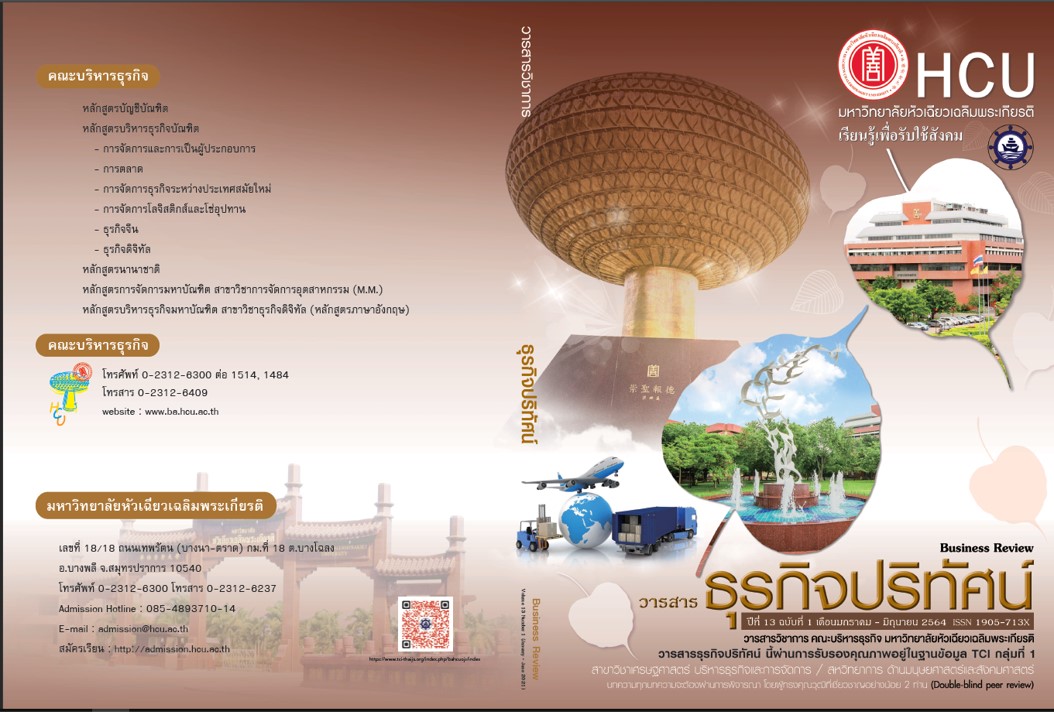Basic Equipment for Snorkeling and Scuba Diving in Marine Tourism : Similarities and Differences
Keywords:
Snorkeling, Scuba Diving, Marine TourismAbstract
Diving in marine tourist attractions in Thailand is popular with both Thai and foreign tourists. This activity is divided into 2 types : (1) Snorkeling, which is moving at the surface level by using snorkel and (2) Deep diving by using underwater breathing apparatus (Self – Contained Underwater Breathing Apparatus – SCUBA) in a depth of several. Both activities use the same basic diving equipment but different in details, can be classified into 3 categories : (1) Basic equipment (2) Accessories and (3) Safety equipment. Shallow diving equipment is made of materials that are thinner than deep diving equipment. Respecting danger in diving, it was found that snorkeling is less dangerous than SCUBA diving. For popularity, snorkeling is more popular because snorkeling equipment is less expensive than SCUBA diving and snorkeling still requires less skill training than scuba diving. After diving, the maintenance of the diving equipment of both types of diving activities needs to be cleaned with fresh water and leave the equipment to air. However, those who are diving should practice skin diving well before developing to be a deep diver.
References
กมลทิพย์ เหล่าอรรคะ. (2548) การจัดการการท่องเที่ยวบริเวณแนวปะการังโดยใช้คู่มือให้ความรู้และสร้างจิตสำนึกร่วมกับทางเชือก. วิทยานิพนธ์วิทยาศาสตรมหาบัณฑิต สาขาวิชาวิทยาศาสตร์สิ่งแวดล้อม (สหสาขาวิชา) บัณฑิตวิทยาลัย จุฬาลงกรณ์มหาวิทยาลัย.
กรมอุทยานแห่งชาติ สัตว์ป่า และพันธุ์พืช. (2561). สถิตินักท่องเที่ยวที่เข้าไปในอุทยานแห่งชาติ
ปีงบประมาณ 2560 – 2561, 26 กันยายน 2562. http://portal.dnp.go.th/Content/nationalpark?contentId=11191
กิตติโชติ งามประสิทธิ์. (2543). การถูกทำลายของปะการังจากการท่องเที่ยวและการฟื้นตัวในระยะสั้นบริเวณเกาะล้านและเกาะริ้น จังหวัดชลบุรี. วิทยานิพนธ์วิทยาศาสตรมหาบัณฑิต สหสาขาวิชาวิทยาศาสตร์สภาวะแวดล้อม บัณฑิตวิทยาลัย จุฬาลงกรณมหาวิทยาลัย.
นฤมล กรคณิตนันท์. (2541). ผลกระทบจากการท่องเที่ยวต่อปะการัง. วิทยานิพนธ์วิทยาศาสตรมหาบัณฑิต สหสาขาวิชาวิทยาศาสตร์สภาวะแวดล้อม บัณฑิตวิทยาลัย จุฬาลงกรณมหาวิทยาลัย.
พัณณ์ชิตา พีระภัคไพศาล. (2548). การพัฒนาการท่องเที่ยวเชิงอนุรักษ์ของทรัพยากรการท่องเที่ยวใต้ทะเลบริเวณเกาะล้าน. ปัญหาพิเศษ การศึกษา รปม., มหาวิทยาลัยบูรพา, ชลบุรี.
พิทยา หมันง๊ะ เจ้าพนักงานป้องกันและบรรเทาสาธารณภัย ฝ่ายกู้ภัยทางทะเล เมืองพัทยา สาขาเกาะล้าน ผู้ให้สัมภาษณ์. อุจฉริต์ อาจาระศิริกุล ผู้สัมภาษณ์ เกาะล้าน เมืองพัทยา เมื่อวันที่ 25 มีนาคม 2558.
บริษัทสื่อเดินทาง. (2019). หน้ากากดำน้ำและอุปกรณ์ดำน้ำ, 30 กันยายน 2562.
http://www.e-travelmart.com/product-category/mask-diving/
หน่วยสงครามพิเศษทางเรือ กองเรือยุทธการ. การดำน้ำ เล่มที่ 1 การดำน้ำด้วยอากาศ. แปลและเรียบเรียงโดย นาวาโท ศุภชัย ธนสารสาคร มกราคม 2544.
วันชัย แจ้งอัมพร. (ม.ป.ป.). คู่มือการดำน้ำแบบสกินไดวิ่ง. กรุงเทพฯ : นิตยสารโลกทะเล.
สมถวิล จริตควร. (2540). ชีววิทยาทางทะเล, ชลบุรี : ภาควิชาวาริชศาสตร์.
สาริยา นุชอนงค์. (2560). การออกแบบเว็บไซต์สำหรับธุรกิจการท่องเที่ยวในยุคดิจิทัล. วารสารธุรกิจปริทัศน์. 9(2), 201 – 214.
อลิศา สงวนนาม เจ้าหน้าที่นันทนาการและสื่อความหมาย อุทยานแห่งชาติเขาแหลมหญ้า – หมู่เกาะเสม็ด ผู้ให้สัมภาษณ์ อุจฉริต์ อาจาระศิริกุล ผู้สัมภาษณ์ เมื่อวันที่ 8 เมษายน 2558.
Briandana, R., Doktoralina, C.M. and Sukmajati, D.. (2018). Promotion analysis of marine tourism In Indonesia : A case Study, European Research Studies Journal, XXI, I, pp. 602 – 613.
Downloads
Published
How to Cite
Issue
Section
License
All articles published in the Business Administration and Management Journal Review are copyrighted by the journal.
The views and opinions expressed in each article are solely those of the individual authors and do not represent those of Huachiew Chalermprakiet University or any other faculty members. Each author is fully responsible for the content of their own article. Any errors or issues found are the sole responsibility of the respective author.




